You may not find this terribly rewarding unless you're included here, so this is a good time for casual and random browsers to turn back before they get too caught up in the sweep and majesty of the proceedings and can't let go.
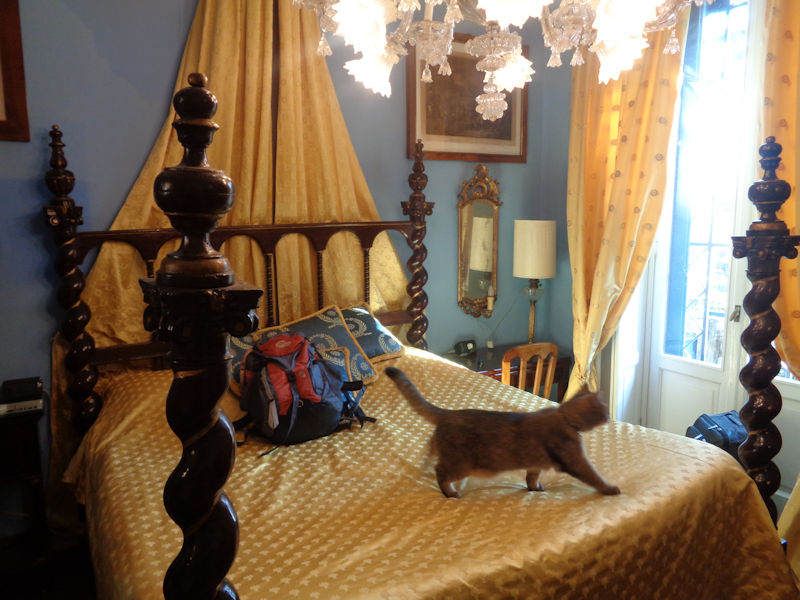
Melvin the Doge settling in in Venegono Superiore; we've left Lodi after a rewarding tourist experience, and we're looking forward to visiting Como tomorrow. Venegono Superiore, and Inferiore, are small towns about 8km southeast of Varese, capital of Varese province in the northwest Lombardy region. 26 February 2018.
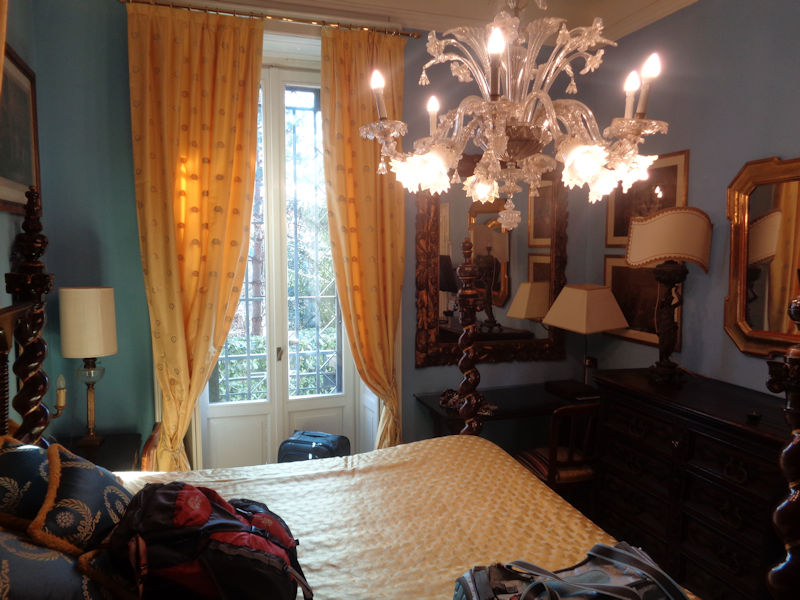
This is our beautiful room in the Villa Puccini, once owned by our amiable host's grandfather Leandro Bisiach, universally considered to have been the premier maker of violins and other stringed instruments in Italy in the late 19th and early 20th centuries. Our host, retired professor Giacomo Bisiach is the grandson and son of instrument makers Leandro and Giacomo Sr, and is a wonderfully personable keeper of the tradition, keen to show off and explain some of the family treasures.
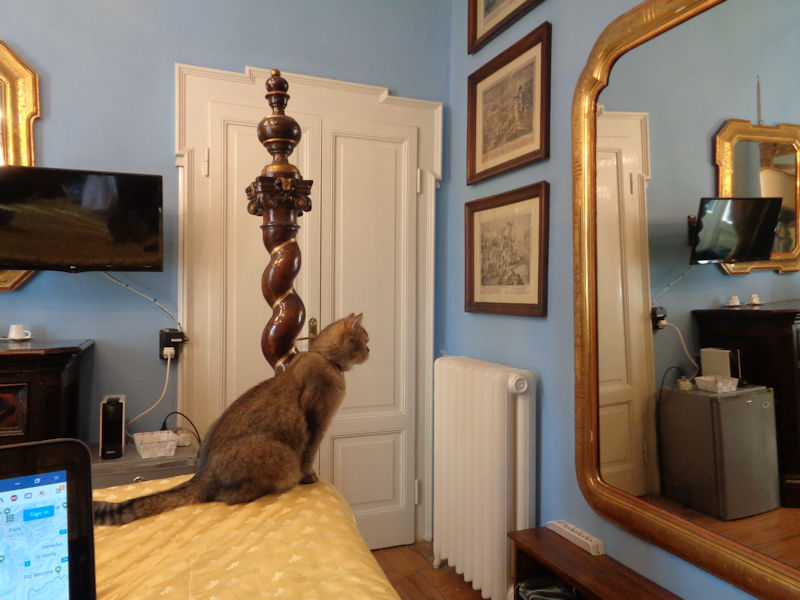
Finally, something that can hold Melvin's attention.

The house is basically a museum to violin-making, and we'll see more of it during our stay here. It's said that Bisiach saved the venerable skills of the great masters of 18th century Cremona (Stradivarius, Amati, etc.) from becoming lost, unearthing old varnish recipes, experimenting with new ones, and bringing up a long list of successors in his Milan workshop whose names are well known to serious violin-maker fans. All of his four sons continued in his footsteps. He was also a violinist and concertmaster of note during much of his career.
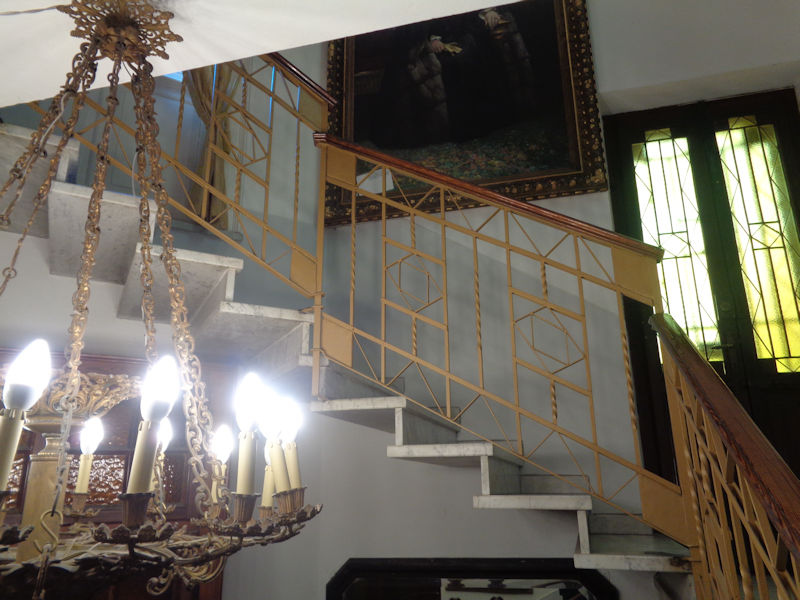
We'll have time to look around here more thoroughly later. In the meantime . . .
Castiglione Olona
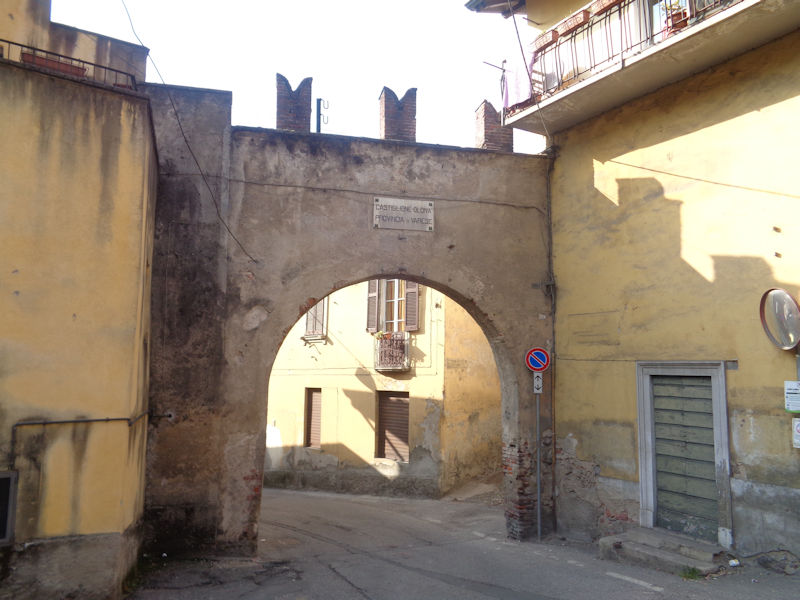
Castiglione Olona, adjacent to Venegogo, is a perfectly functional if uninspiring town of about 8,000 citizens strung along the SP233 (the Via Cesare Battisti) and adjacent neighborhoods, but down the hill near the tiny river Olona is the medieval old town, entered through this gate.

And down this hill. Castiglione on the Olona river has been known since the 5th century AD, and under the Lombards the local family that took the name Castiglione as their own succeeded in getting hold of most of the surrounding land by the year 1000.

The family came into its own in the 14th century, when Branda da Castiglione was noticed by the Visconti of Milan and sent through for his doctorate in law in Pavia -- in 1389 he was sent by Giangaleazzo Visconti to the papal court of Boniface IX as a lobbyist; before long Boniface had made him his own chaplain and began sending him off on diplomatic missions, including to Germany and Flanders, Hungary and Transylvania in 1403, where he became close fiends with Sigismund the King of Hungary, who later became the Holy Roman Emperor. (That's the Tuscan-style palace he built here, in the later-named Piazza Garibaldi in downtown medieval Castiglione. We'll come back to that later.)

The temperature is about 0°C at the moment, so we're hurrying right along.

This is the Chiesa del SS. Corpo di Cristo, built between 1437 and 1444, soon to be frescoed by Masolino da Panticale, whom Branda Castiglione brought in to take a leading role in the work on his new church up the hill. The strangely huge statues are said to be of St Anthony and St Christopher.
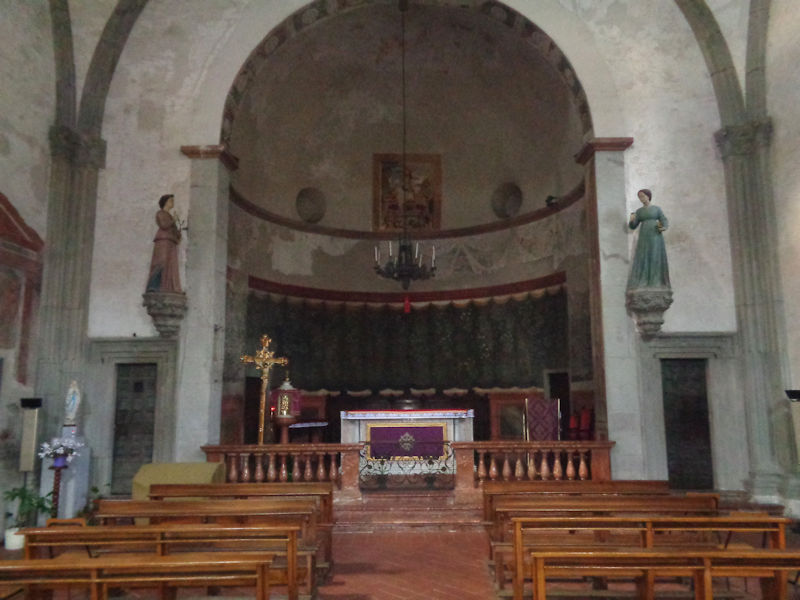
A very nice and spartan interior; the statues flanking the apse show the Angel Gabriel of the Annuncation, on the left, and the Virgin Mary with a book
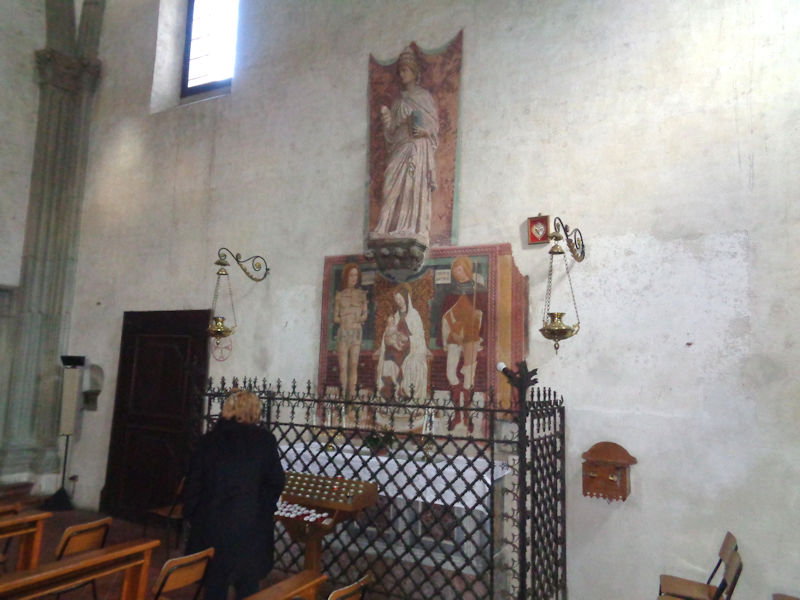
That's Guido da Castiglione in the sarcophagus, and some familiar figures in the frescoes

St Sebastian with more arrows than should have been necessary, and St Rocco showing of his buboes from the plague. From the mid-15th century onward, they are very frequently shown together. That's called the 'Virgin of Grace' in the centre.
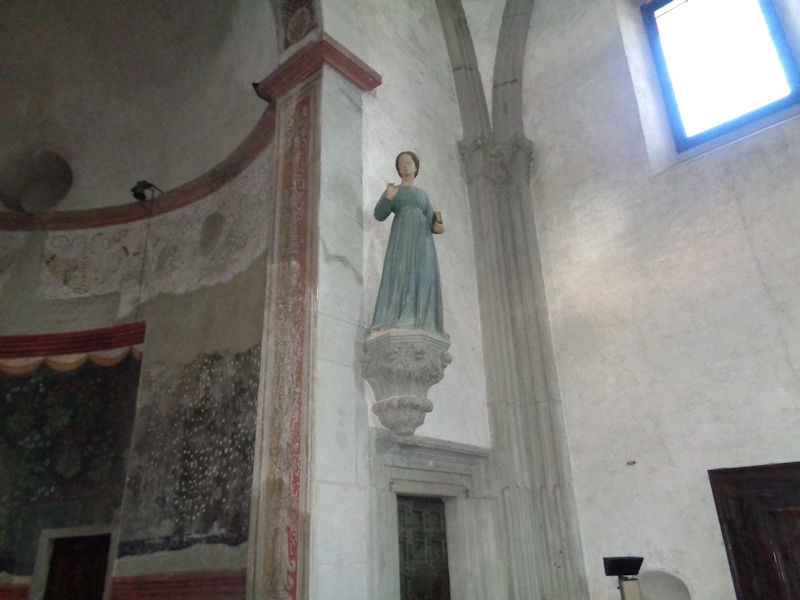
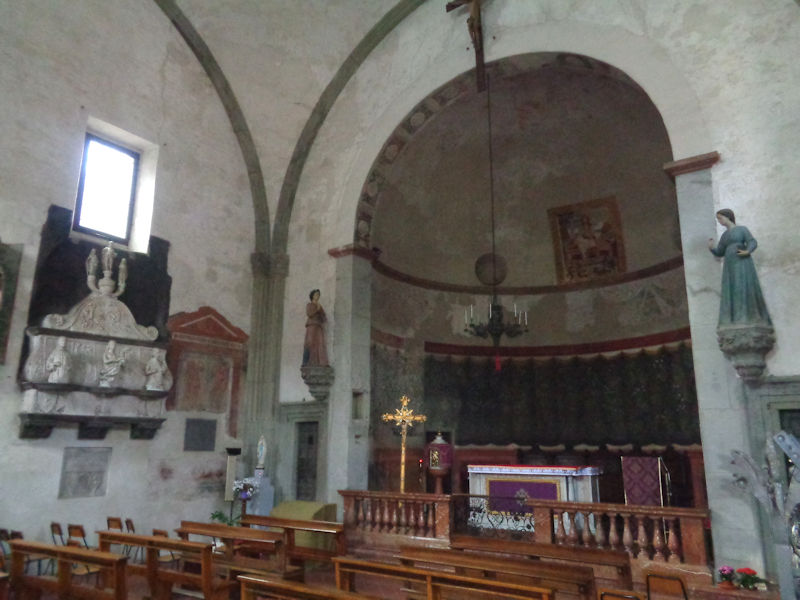
Scenes of the pretty much unaltered medieval church in central Castiglione Olona

Now we'll just dash up the hill towards the Baptistery and Collegiate Church that Cardinal Branda Castiglione (a cardinal after 1411) got permission in 1421 to build here.

That's it, the collegiate church and baptistery of Castiglione Olona.

Downtown old Castiglione -- the modern version of the town is looming up the hill in the background.

The Scuola di Canto e Grammatica, or Singing and Grammar School, founded by Cardinal Castiglione in 1423, now apparently part of the city hall premises.

The river Olona below, where the mills and factories still seem to be.

Sans paroles

Wait up!

This is the premises of what on the plaque is advertised as the Complex (and Castello medioevale) of the Collegiate della Beata Vergine del Rosario e dei SS. Lorenzo e Stefano, built by Cardinal Branda Castiglione, 1422-1425. And the Baptistery/Chapel of San Giovanni Battista, frescoes by Masolino da Panicale, 1435.

It is, however, closed today. We'll come back tomorrow.
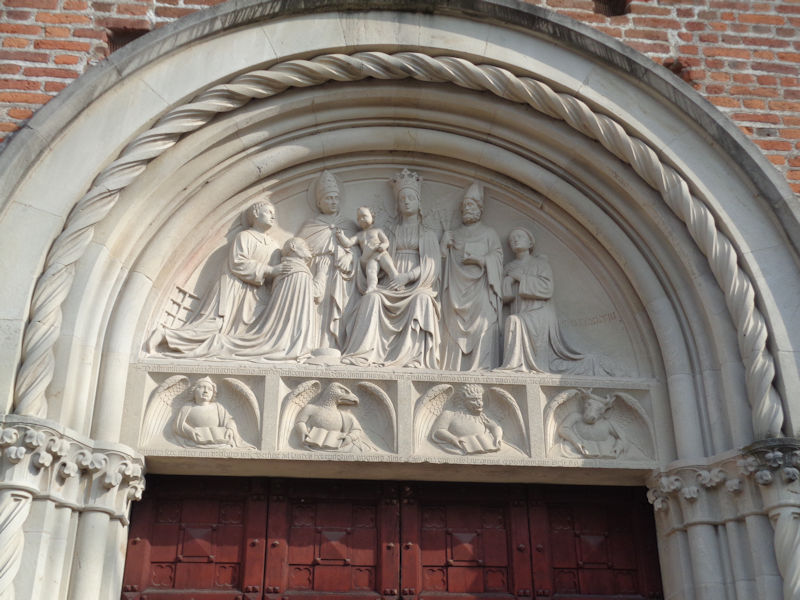
In the tympanum over the front door, dated 1428, the Madonna etc. with St Ambrose, St Clement, St Lawrence, and St Stephen, and with Cardinal Castiglione offering up his church. Below the lunette are the conventional symbolic representations of the four evangelists, Matthew, John, Mark, and Luke.

Back downtown; that's called, in the English translation of the guide leaflet, the 'Pious Place of the Poor of Christ', intended by the will of Cardinal Castiglione for the relief of the village poor and pilgrims passing through.

A quick and chilly walk round town, though there's not much of it. This is the Square of the Eternal Father, with remains of a 17th century fresco honoring St Carlo Borromeo, who visited here in 1570, and with on the left a marble carving of the crest of the Archpriest Pietro Castiglione.

The Palace of the Cardinal's family, 15th century

A cute little Volvo, right there in the Piazza Giuseppe Garibaldi
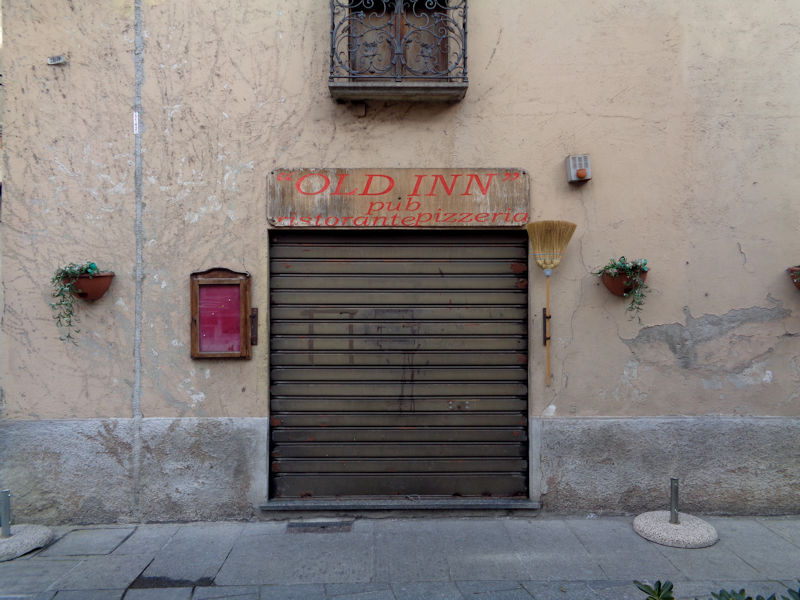
The "Old Inn" pub

The Palazzo Clerici, 15th century

The Via Roma leading out of town and the Western Arch that was part of the town walls, with the 'Edificio Medioevale' from the 14th century

Up towards the top city gate
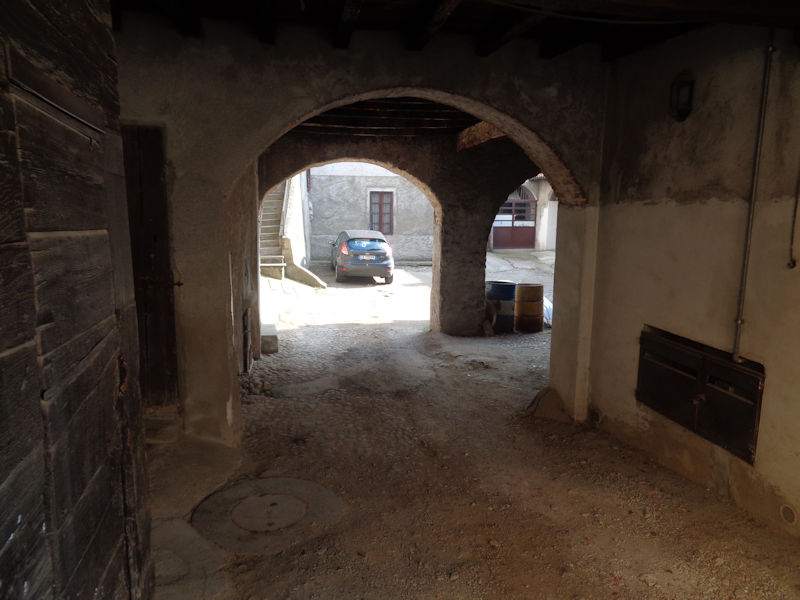
Courtyards

The Osteria degli Artisti, antica locanda since 1998: 'cucina tipica'

Back to Garibaldi Square
We're back
We've spent much of the day visiting Como, 27 February 2018, but in late afternoon we've rushed back to Castiglione Olona to get inside this collegiate church and see these famous Masolino frescoes.

The Palazzo Branda Castiglioni - Museo Civico -- our first order of business. Cardinal Castiglione is sometimes referred to as a 'pseudo-cardinal' because he was raised to the College of Cardinals in 1411 by Pope John XXIII, who was later determined by the Council of Constance (1414-18) to have been one of the 'Anti-Popes' of the Schism. But his career as a high churchman and papal legate continued with no sign that anyone questioned his role; the new Pope, called Martin V, gave him a palace in the Piazza Navona in Rome as his residence in town and sent him on missions as his legate to Bohemia and Hungary, and in 1431 he was one of the 14 members of the College of Cardinals that elected the next pope, Eugenius IV.

In the early 1420s, already over 70 years old, Branda began spending more time back in Castiglione Olona -- he received permission to build the Collegiate Church on the hill, and he set about repairing the village and its walls. Amongst which he built his palace here, just up the street from the residence his larger family built, with a stated view of introducing Renaissance styles to what amounts to this northern backwater. The Renaissance loggia, how glassed in, is just above us.

Which is why the town now describes itself as an 'island of Tuscany in Lombardy'

The great hall, called the Room of Portraits

A view out the back window

The Cardinal's Room, also built in 1423, festooned with naked little boys

Just sayin'

In fact, the museum has set the room up as a bedroom, but the explanatory paper indicates that it could just as easily have served as a study or reception room.
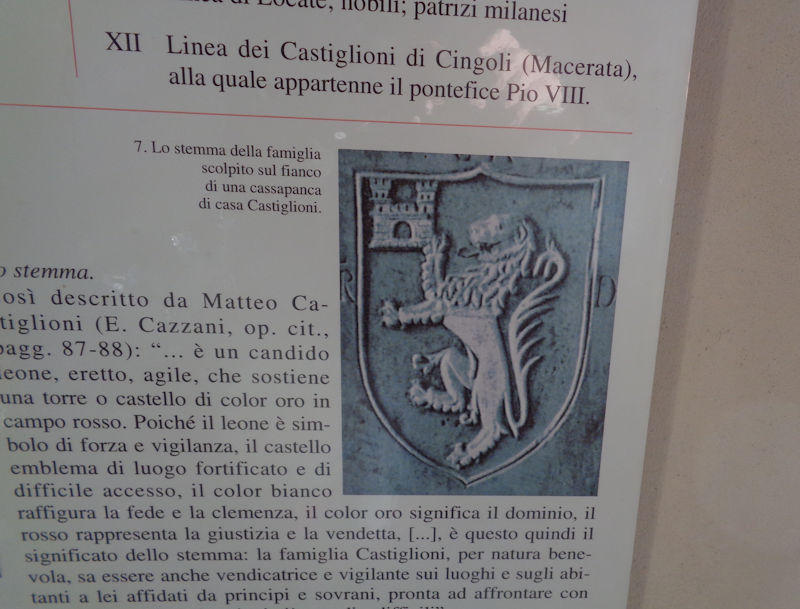
The Castiglione 'stemma' or coat of arms -- a rampant lion with a castle. Of course.

Frescoes in the little chapel, either by Masolino or by il Vecchietta -- the Cardinal was well known as a big fan of the literary and artistic movements underway in early Renaissance Italy, and he had run into the artist Masolino da Panicale in Rome, who was working there for Pope Martin and others with his colleague Masaccio in the early 1420s. The Cardinal convinced Masolino to accompany him on his mission to Hungary for three years, 1425-28, and by 1435 he had enticed the artist here to work on this palace, as well as on the new Collegiate Church and some of his other projects for the town. These include the Chiesa del Santissimo Corpo di Cristo, which we visited yesterday; a school for boys in the neighborhood, the Scuola di Canto e Grammatica; a town library; and a convent for female members of the Order of the Humiliati.

Up the hill

The renovations underway on the right are described on the sign as the 'Palazzo dei Marchesi Magenta di Milano, 15th-16th centuries'

Wait up!

It's open today, and one of the knowledgeable guides is very pleased to take us around, chiefly in order to work on her English. Signs proclaim this to be a 'No Photo' establishment, which is a serious downer, though that may not have been entirely true, since, too late, our guide mentioned that that was only meant for the tourists wandering around unguided.

The façade of the gloriously named Collegiate della Beata Vergine del Rosario e dei SS. Lorenzo e Stefano, built 1423-25. We, however, will be entering by the little side door.

That one. The church complex is built on the site of an ancient fortress which was stormed and destroyed in 1271 by the Torriani in revenge for the Castiglionis having gone over to support the Visconti in the battles for control of Milan. Once the Visconti had cemented their control of this region, there was no longer a military purpose for a fortress here, but bits remain after the construction of the Cardinal's church on the spot.

We got to see some interesting frescoes all over the place, but this was before we semi-understood that 'No Flash' might have worked just as well. In any case, Cardinal Castiglione retired to his little town in December 1442 and died in his Palazzo here in February 1443, at the age of 93. That is evidently his sarcophagus up there in the apse, tucked away just to the left side.

Our guide is leading us over to the Baptistery, the small building in the background, where there are some really interesting Masolino fresco cycles, of which I have no photos.

Back down the hill and time for dinner in Venegono Superiore.
Next: Sightseeing in Como (yesterday)

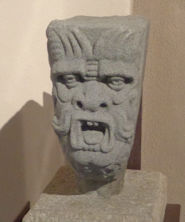 Dwight Peck's personal website
Dwight Peck's personal website





















































